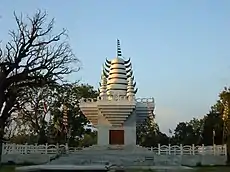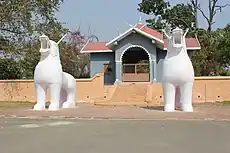Meitei culture
The culture of Meitei civilization evolved over thousands of years, beginning in Ancient Manipur, continuing most notably into Medieval Manipur, while influencing the neighboring states and kingdoms.

Arts
Architecture

The architectural works of the Meitei ethnicity is best known through its Meitei temples as well as ancient buildings including palaces, court halls, offices, entrance gates and so on.
Literature
Meitei literature dates back right from the 15th century BC, during the era of Tangcha Lee La Pakhangpa (Tangja Leela Pakhangba) (1445 BC-1405 BC) in Ancient Manipur. The Puya (Meitei texts) account for most of the accounts for the literary works till Medieval Manipur.[1]
Some of the most prominent Puyas, written in Meitei language (Manipuri language),[2] are given below in alphabetical order:
- Chada Laihui
- Chainarol
- Chothe Thangwai Pakhangba
- Hijan Hirao (Hichan Hilao)
- Khongjomnubi Nongarol
- Khuman Kangleirol
- Khumanlon
- Konthoujam Nongarol
- Leishemlon
- Leithak Leikharol
- Moirang Ningthourol Lambuba
- Ningthourol Lambuba
- Nongban Pombi Luwaoba
- Numit Kappa
- Panthoibi Khongul
- Phouoibi Waron
- Poireiton Khunthok
- Sakok Lamlen
- Sanamahi Laihui
- Tharon (Thalon)
- Toreirol Lambuba
- Tutenglon
- Wakoklon Heelel Thilen Salai Amailon Pukok Puya
Public holidays and festivals
Important days fall in different times of a year according to Meitei calendar. Some are as follows in alphabetical order:
- Cheiraoba (ꯆꯩꯔꯥꯎꯕ)- 1st of Sajibu month
- Emoinu Eratpa (ꯏꯃꯣꯢꯅꯨ ꯏꯔꯥꯠꯄ)- 12th of Wakching month
- Heikru Hidongba (ꯍꯩꯀ꯭ꯔꯨ ꯍꯤꯗꯣꯡꯕ)- 11th of Langban month
- Kwaak Taanba (ꯀ꯭ꯋꯥꯛ ꯇꯥꯟꯕ)- 10th of Mera month
- Mera Chaorel Houba (ꯃꯦꯔꯥ ꯆꯥꯎꯔꯦꯜ ꯍꯧꯕ)- 1st of Mera month
- Mera Hou Chongba (ꯃꯦꯔꯥ ꯍꯧ ꯆꯣꯡꯕ)- 15th of Mera month
- Ningol Chakouba (ꯅꯤꯉꯣꯜ ꯆꯥꯛꯀꯧꯕ)- 2nd of Hiyangei month
- Panthoibi Iratpa (ꯄꯥꯟꯊꯣꯢꯕꯤ ꯏꯔꯥꯠꯄ)
- Sanamahi Ahong Khong Chingba (ꯁꯅꯥꯃꯍꯤ ꯑꯍꯣꯡ ꯈꯣꯡ ꯆꯤꯡꯕ)-
- Yaoshang (ꯌꯥꯎꯁꯪ) -15th of Lamtaa month, Full moon
Religion

Sanamahism, the Meitei religion, has thousands of Meitei deities.The List of figures in Meitei mythology accounts for the characters in Meitei mythology, the receptacle of the Meitei religion.[3]
Lai Haraoba
The "Lai Haraoba" festival is an ancient ritualistic music and dance festival, often performed in order to please the Umang Lais and the Lam Lais, whose pantheons are found scattered in the plains of Manipur still today.[4][5][6][7][8][9][10]
Jagoi, originally spelled as Chatkoi, is the traditional form of dancing, performed by the devotees to please the deities. Here is a list of the "Chatkoi"s ("Jagoi"s) :
C
K
L
M
P
T
Death ceremony
The Meitei people perform four types of death ceremony since time immemorial. These are:
- Air ceremony (Disposal to the space)
- Earth ceremony (Burial)
- Fire ceremony (Burning)
- Water ceremony (Disposal to the water bodies)
Relationship with nature
In Meitei mythology and Meitei folklore of Manipur, deforestation is mentioned as one of the reasons to make mother nature (most probably goddess Leimarel Sidabi) weep and mourn for the death of her precious children. In an ancient Meitei language narrative poem named the "Hijan Hirao" (Old Manipuri: "Hichan Hilao"), it is mentioned that King Hongnem Luwang Ningthou Punsiba of Luwang dynasty once ordered his men for the cutting down of woods in the forest for crafting out a beautiful royal Hiyang Hiren. His servants spotted on a gigantic tree growing on the slope of a mountain and by the side of a river. They performed traditional customary rites and rituals before chopping off the woods on the next day. In the middle of the night, Mother nature started weeping in the fear of losing her child, the tree.[11][12][13] Her agony is described as follows:
At dead of night
The mother who begot the tree
And the mother of all giant trees,
The queen of the hill-range
And the mistress of the gorges
Took the tall and graceful tree
To her bosom and wailed:
"O my son, tall and big,
While yet an infant, a sapling
Didn't I tell you
To be an ordinary tree?
The king's men have found you out
And bought your life with gold and silver.
* * At daybreak, hacked at the trunk
You will be found lying prostrate.
No longer will you respond To your mother's call
Nor a likeness of you
Shall be found, when I survey
The whole hillside.Who shall now relieve my grief?"
References
- Kriti Rakshana: A Bi-monthly Publication of the National Mission for Manuscripts. National Mission for Manuscripts. 2006. Archived from the original on 2022-05-08. Retrieved 2022-04-22.
- "Archived copy". Archived from the original on 2021-05-13. Retrieved 2021-04-03.
{{cite web}}: CS1 maint: archived copy as title (link) - "The Manipuri Lais". Archived from the original on 2020-09-26. Retrieved 2021-04-03.
- "D'source Umanglai - Sacred grove of Manipur | Sacred Groves | D'Source Digital Online Learning Environment for Design: Courses, Resources, Case Studies, Galleries, V..." 23 September 2015. Archived from the original on 2020-01-29. Retrieved 2021-04-03.
- "Sacred groves Manipur need urgent attention". Archived from the original on 2019-08-10. Retrieved 2021-04-03.
- "Sacred Groves in Manipur". Archived from the original on 2020-01-25. Retrieved 2021-04-03.
- "The Manipuri Lais". Archived from the original on 2020-09-26. Retrieved 2021-04-03.
- Banerji, Projesh (1956). Dance of India. Kitabistan. Archived from the original on 2022-05-08. Retrieved 2022-04-22.
- Playne, Somerset (1917). Bengal and Assam, Behar and Orissa: Their History, People, Commerce, and Industrial Resources. Foreign and Colonial Compiling and Publishing Company. Archived from the original on 2022-05-08. Retrieved 2022-04-22.
- Sarat Chandra Roy (Rai Bahadur (1981). Man in India. A.K. Bose. Archived from the original on 2022-05-08. Retrieved 2022-04-22.
- Singh, Ch Manihar (1996). A History of Manipuri Literature (in English and Manipuri). Sahitya Akademi. pp. 16, 17. ISBN 978-81-260-0086-9.
- Datta, Bīrendranātha; Śarmā, Nabīnacandra (1994). A Handbook of Folklore Material of North-East India. India: Anundoram Borooah Institute of Language, Art & Culture, Assam. p. 356.
- Barua, Lalit Kumar (1999). Oral Tradition and Folk Heritage of North East India. India: Spectrum Publications. p. 71. ISBN 978-81-87502-02-9.
- Singh, Ch Manihar (1996). A History of Manipuri Literature (in English and Manipuri). Sahitya Akademi. pp. 16, 17. ISBN 978-81-260-0086-9.
- Datta, Bīrendranātha; Śarmā, Nabīnacandra (1994). A Handbook of Folklore Material of North-East India. India: Anundoram Borooah Institute of Language, Art & Culture, Assam. p. 356.
- Barua, Lalit Kumar (1999). Oral Tradition and Folk Heritage of North East India. India: Spectrum Publications. p. 71. ISBN 978-81-87502-02-9.